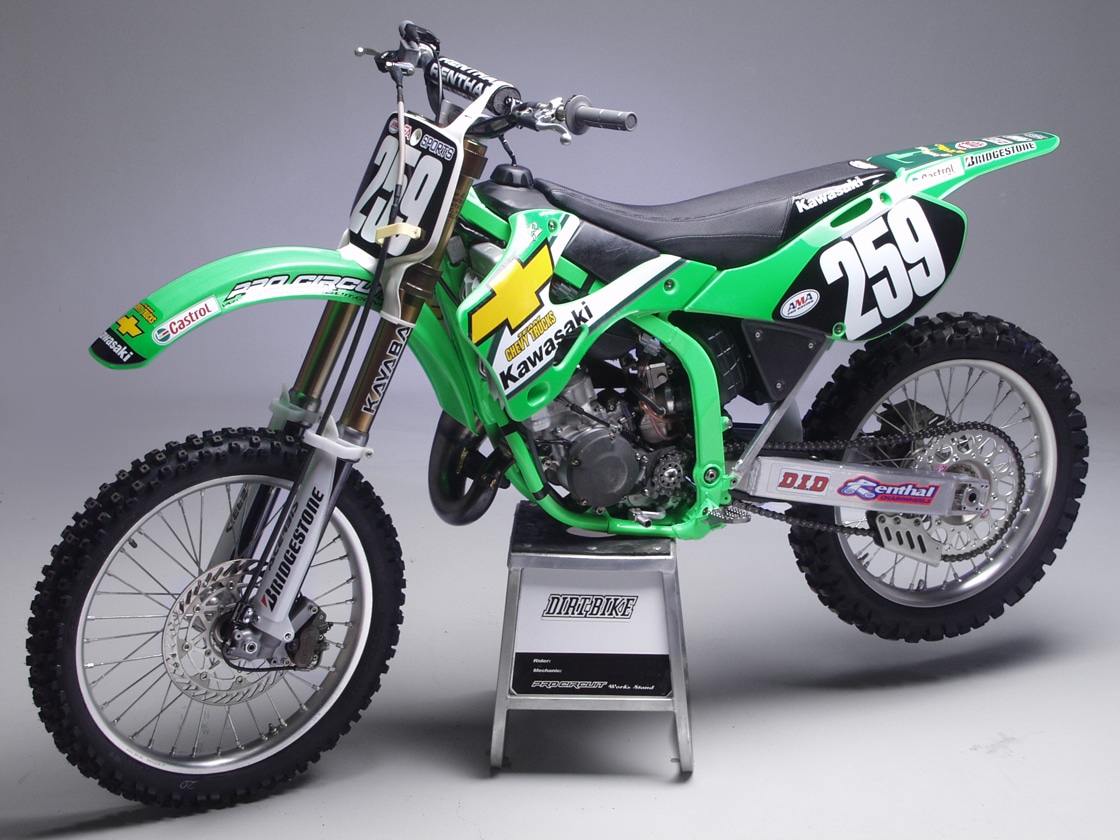JAMES STEWART’S FACTORY 125 TWO-STROKE
Back in 2002, James Stewart was something special and everyone knew it. For the first time in years, Kawasaki took its 125 program in house, just for him. Previously, all the 125 riders were farmed out to Pro Circuit so that Team Kawasaki could concentrate on the big 250 stars like Carmichael and Jeff Emig.

So when Kawasaki did that, did they have to start from scratch? “We never really stopped developing the 125,” said Kawasaki’s Bruce Sjernstrom, back in the day. “We had it on the backburner all along. That year, the 125 cylinder was all new, so that meant we had to do some new development, but so did Pro Circuit. Mike Brown could ride a fast, pipey 125 with no problem. He seemed to like them that way. But for James we had to get more bottom and mid-range power. Rick Asch built the motor and we actually had Jeff Emig help with the testing.”

Kawasaki was so proud of its 125 effort that Bruce and the crew had no problem bringing the bike out for us to try, right in the middle of that 2002 season.It was obvious that Stewart’s Kawasaki was an all-out factory effort. The list of unobtainable factory parts was long. The centercases and the cylinder started off as stock parts, but everything else was special. The six-speed gearbox had different ratios set up for Supercross. The outer cases were magnesium. The Mikuni carb didn’t look like anything we had seen before. It had both a PowerJet and a throttle position sensor wired into an ignition that was, of course, programmable. The pipe was specially made by Pro Circuit and the reed valve was specially made by Moto Tassinari. Stewart wasn’t a big guy (not yet), so the seat height had to be dropped for him. About 8mm was taken out of the subframe, the seat foam was shaved and even the seat brackets were shortened. It all amounts to almost two inches. And under that seat was a carbon fiber airbox made locally by Berg Racing.

Was it fast? Yes and no. All the power was right in the middle. It was a little soft way down low, but when it hit, it hit hard. We thought it signed off early, even by the standards of 2002, but it was deceptive. It made so much in the middle that the top felt comparatively mild. At the time, Pete Murray rode the bike for us. He put it well: “The bike is great. But it wasn’t the bike that won those races.” What you saw on the track was pure Bubba.
CLASSIC ROGER
In 1993, Roger DeCoster was on staff full time. He was between his Honda and Suzuki gigs, and we wrote a bunch of stories together. Keep an eye out for them on the website as well as in print. Click on the image above for his racing tips from 1993. They are still as relevant today as ever.
WORCS ANNIVERSARY
WORCS is about to celebrate its 20th anniversary. I’ve been looking through some old photos. Funny, it seems like only a few years ago that it all began.




HUSKY NORDEN 901
This week I’m attending the introduction of the Husqvarna Norden 901. Look for a full review next week!
UPCOMING EVENT
MXGP ROUND 16
Frenchman Maxime Renaux just clinched the MX2 championship in Italy with two rounds to spare. In the meantime, Romain Febvre, Tim Gajser and Jeff Herlings are separated by only 3 points for the 2021 MXGP title. The final two rounds should be amazing!
See you next time!
–Ron Lawson






Comments are closed.